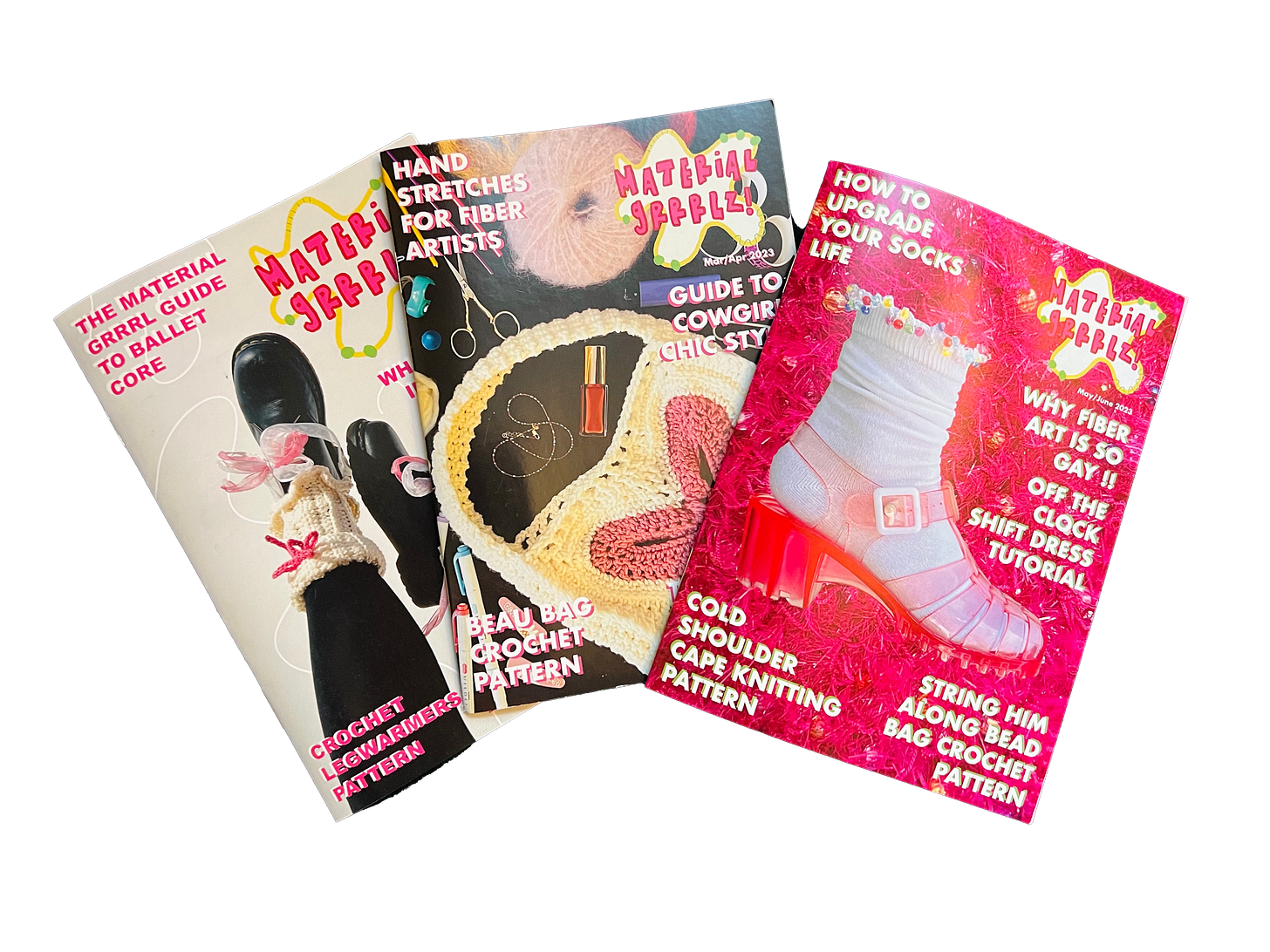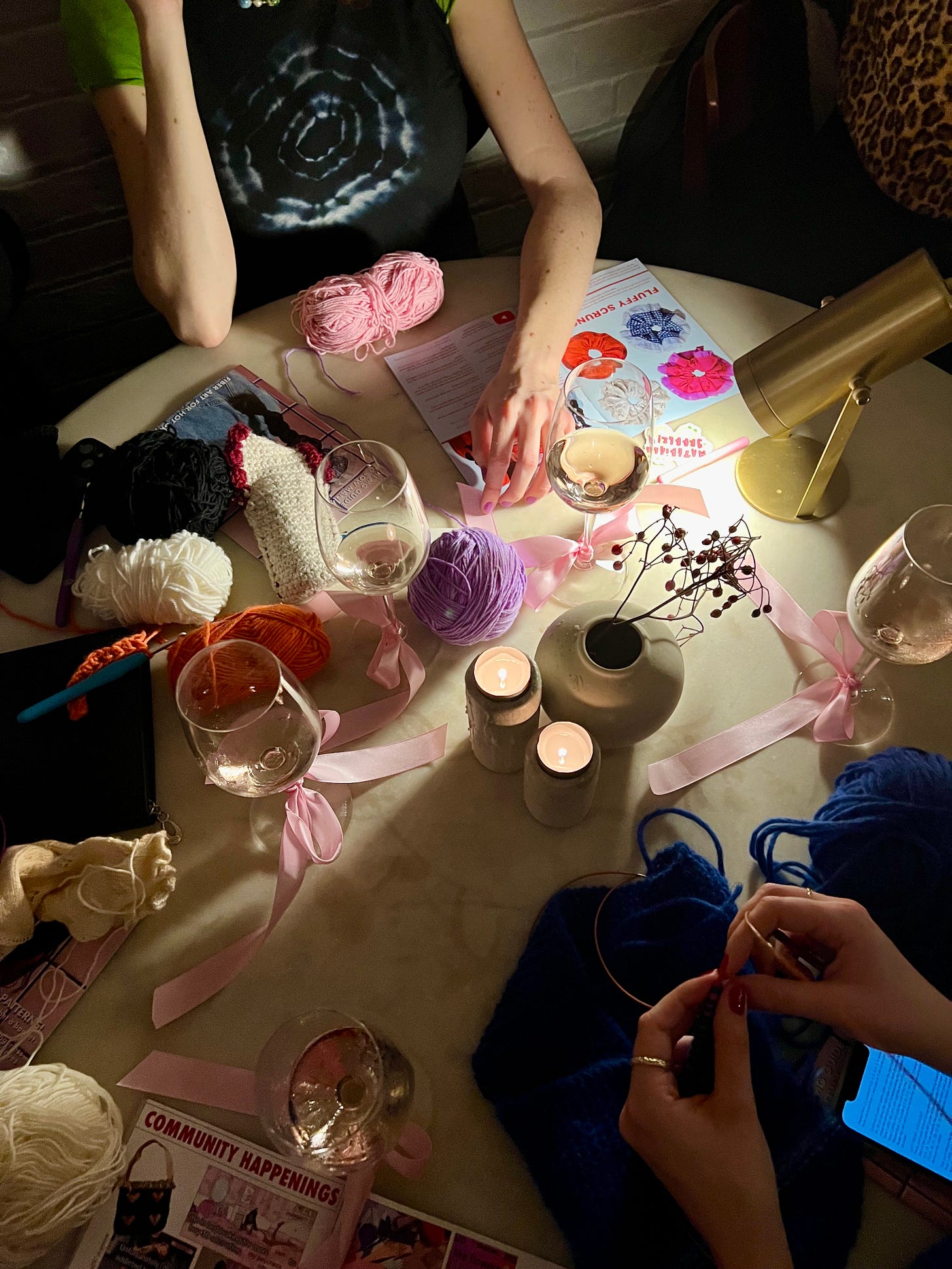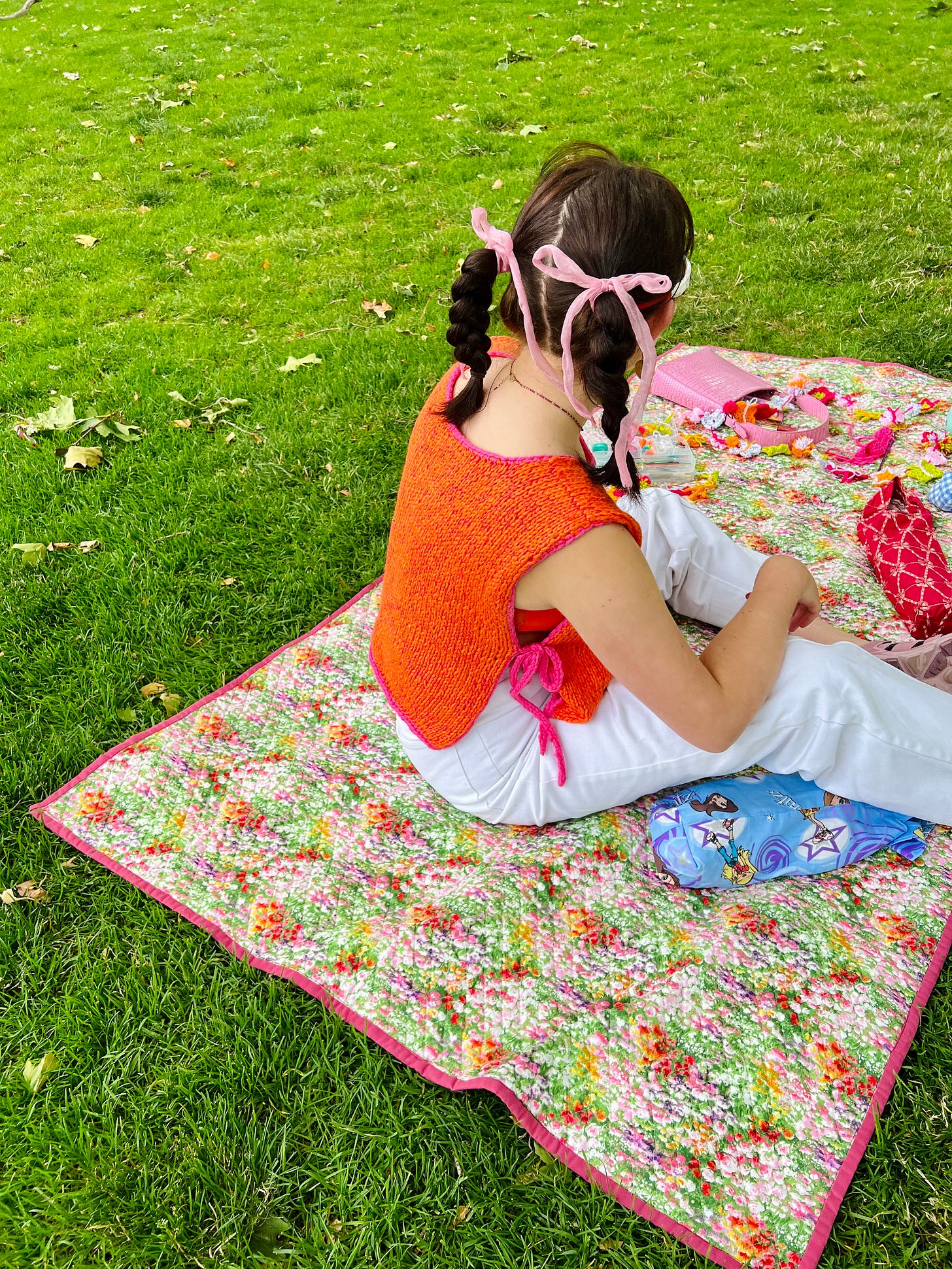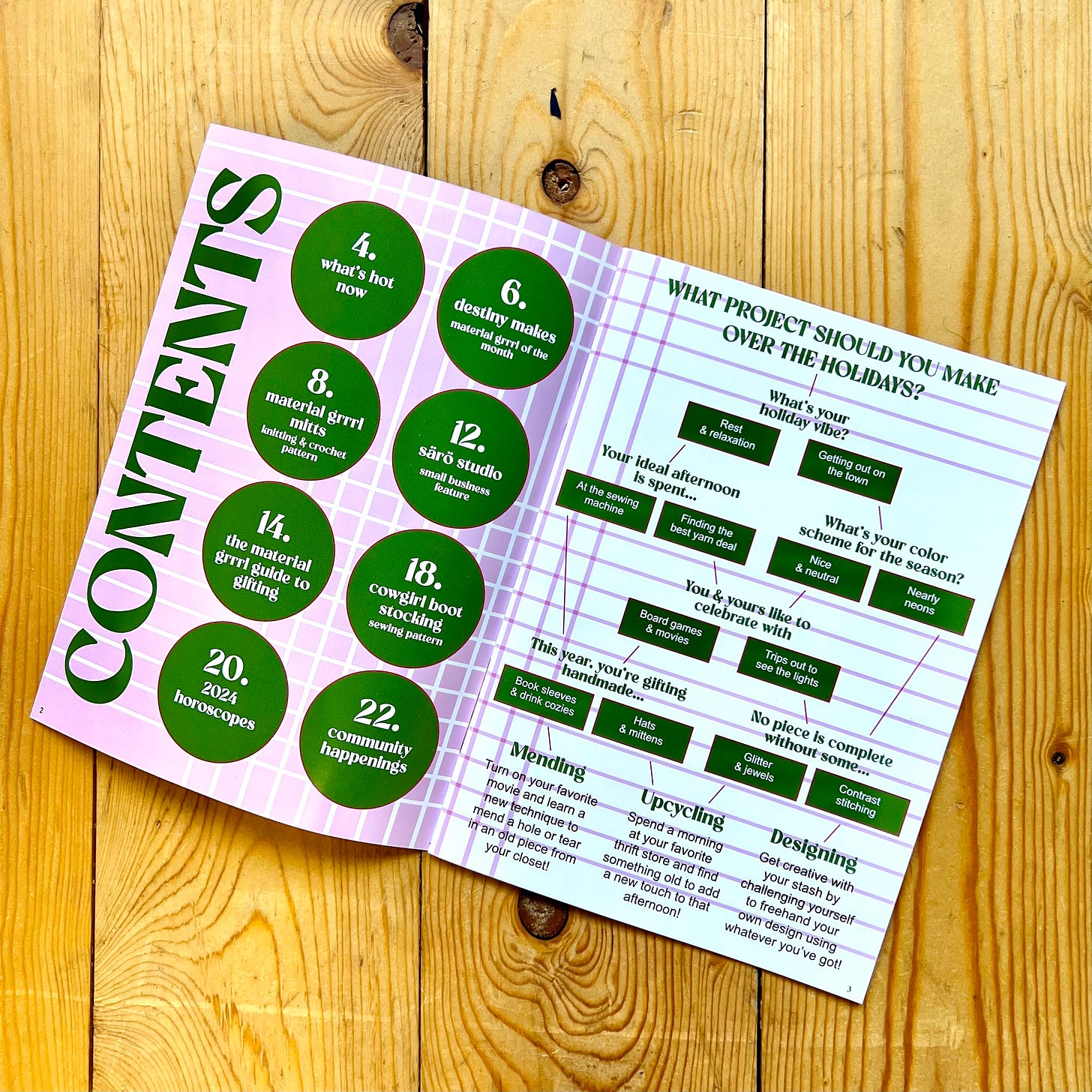Material Grrrlz is building a fiber arts community through memes, meetups, and a magazine
A conversation with Material Grrrlz founder Alexa Kari.

This newsletter features a conversation with Alexa Kari, the founder of the fiber arts community Material Grrrlz. The community is both online and offline, including a quarterly print and digital magazine, Instagram page, and in-person workshops in London.
“What started as an Instagram page full of sloppily-edited memes for (I thought, at the time) an incredibly niche audience, is now a thriving community of creatives in over 90 countries…and a love letter to the creativity of women and queer people,” Kari wrote in the Q1 2025 issue of the magazine. “Around here, we take girly shit seriously; regardless of gender, everyone has a relationship to and experience of girlhood, and we welcome anyone that wants to respect and celebrate that with us.”
This interview has been edited for clarity and concision.
PHONE TIME: Can you start by telling me a bit about how Material Grrrlz started?
ALEXA KARI: It started in the summer of 2022. I had just graduated from college in Minnesota and was looking for a further creative outlet. I was getting kind of existential—like, “What am I going to do to be an artist without all the studios, degree programs, and professors?” But I was into fiber art, and I didn’t really know anyone in my real life who was also into that. I decided to go looking on the internet for some community.
I started the meme page that summer. I feel like every couple of years the Little Miss memes go around, and they were going around at that time. I thought, “What if I made this, and put fiber arts stuff on it?” That was one of the first memes that got me excited.
I kept posting, not regularly. I didn’t really expect people to find it or follow it. I was just looking for something kind of funny to do. Eventually, I realized that there was a community interested in this. As the memes were going on, I started talking about more of the political topics within fiber arts: sustainability, craft vs. fine art, things like that.
Now, I schedule daily posts, and I have built out a broader community. But it did all start with the meme page, because I was looking to connect with other Gen Z girls in their 20-something era.
PHONE TIME: Why do you think the meme page has stood out to people so much?
KARI: I think it’s a bit surprising and silly to see the niche of fiber art combined with niche internet references. So when people who are interested in both see that, they’re a little surprised and excited that others are into the same thing.
I use the same pink fonts and backgrounds for all the memes, and the magazine has a very high-femme, pink aesthetic as well. I’m really passionate about girlhood and helping people connect creatively to it. Having a space where it’s all hot pink and there’s no condescension, because it’s fun, and we’re all there hanging out.
Everything is very inspired by early birthday parties. In every part of Material Grrrlz—the meetups, the magazine, the memes—I want that to shine through. I think it does have a very cohesive visual identity.

PHONE TIME: You’ve also built, from the meme page, an offline community—meetups and a magazine that’s both digital and print. How did you build that out?
KARI: When I started the meme page, I didn’t really realize there was going to be a further community. So it was exciting that people were looking for ways to connect besides just the meme page.
Soon after starting the meme page, I started a group chat on the app Geneva. That was the first time I was trying to get people gathered together in a more intentional space. Since then, I’ve hopped around to different group chat platforms, but that was another early phase of Material Grrrlz.
The magazine started in January 2023, and I had just moved to London from Minnesota. I was in my first 9-to-5 job, and I was in a big city. I was feeling inspired, but also wanting a creative outlet.
I’ve always been inspired by zines, self-publishing culture, and people who scrap things together. I wanted to translate the ideas that I love, into something that young women and queer people would like about fiber art. I was thinking, “I want to make a publication where I share free patterns that are accessible to young people, and fun little handbags you can make in the afternoon and then take out to the club with you in the evening.”
The magazine has always been both print and digital. Digital because I can offer it for free—accessibility is really important to me. But also in print, because I love shipping things, sending out snail mail, feeling things in my hands. I feel like that’s important specifically to people in the craft community.

The workshops and meetups started in August 2023. I was in London and realized that I had more access to a large community and cultural center. I didn’t know that many fiber art workshops and meetups happening around me, specifically ones centered around girlhood and crafting with other young people.
I posted a TikTok and said, “Hey, I’m hosting this space—anyone who wants to come is welcome” and put out tickets. I think about 25 people came to the first one.
We’ve done one every month since. They usually sell out at around 35 people now. Some people are regulars, and we always have some new people who find us online.
When you get out of school, when you’re a young adult, it’s hard to find these spaces where you can go and genuinely meet new people. I see people get excited about Material Grrrlz as a space where they can do that. But the internet side is really important. Not only is that how a lot of people find our in-person events, but it’s also a way that people around the world can engage with Material Grrrlz.

PHONE TIME: I was going to ask about how you think about the balance of doing both online and offline community—you just touched on that. Earlier, you mentioned the political aspects of fiber arts. How do you think about that, and why do you think that’s important for the Material Grrrlz community?
KARI: For my age in general, we’re thinking about sustainability. Like: Are we going to have an Earth to live on when we’re in our 80s? What does that look like? Can I repair things instead of buying them new? Can I make things myself?
I think the politics of gathering with other women is really important to people. There’s a long history of women and queer people gathering together to create things. And with that comes a lot of politics: we talk about the way that craft spaces aren’t as well-invested in as fine art spaces. Fine art spaces tend to be filled with men. Anything that uses textiles, that are generally women-led or have historically mostly had women working in them, there’s not the same amount of money, resources, or respect.
Sometimes people join Material Grrrlz for fun, and then start uncovering those politics. When you learn how to make your own clothes, you realize how much work it takes to make a piece of clothing. I think a lot of people assume that machines are out there that do this, and that’s not true. All pieces of clothing have to be made by a human. As you get further into craft, you realize that there is something so necessarily political about this.
That’s something that’s quite unique to Material Grrrlz. There are a lot of fiber arts spaces where that’s not happening, and in fact, that’s even being shut down. A lot of fiber art people say “This is my safe space, don’t bring politics into it.” But I think that’s a bit ignorant of all these things.
I think people come to Material Grrrlz because this is a space where we can have conversations, recommend books, learn more, share resources. There are not a lot of spaces in fiber arts that are prioritizing that, unfortunately.

PHONE TIME: So we’ve kind of gone through the history of Material Grrrlz, and also the philosophy around it. How do you see the community continuing to evolve?
KARI: It’s kind of up in the air for the first time. I recently launched a Craft Club Finder so people could find other craft circles near them, and I’d love to build that out further. I don’t quite know what that looks like. If there’s a way that I can help people start their own craft clubs, or make the map more interactive, or make it more seamless.

Something that has been important to me, in using the online space, has been democratizing people being able to connect with one another. On social media, we can work really hard on something and put it out there and no one sees it because of the algorithm, or because it’s a lot of work to build a following, and not everyone wants or has the time to invest in that.

With the group chats, the free magazine, and having the meme page as a place to chat in the comments and hang out, a goal of mine is to give people a space where you can put your creation up in the group chat and everyone sees it, and there’s no algorithm determining that. I want to help people have a positive, creative space to share stuff.
You can find Alexa Kari at alexakari.com and on Instagram @a.lexakari. You can find Material Grrrlz at @materialgrrrlz on Instagram, on YouTube, on Substack, and at materialgrrrlz.com.




material grrrlz world domination prevails!